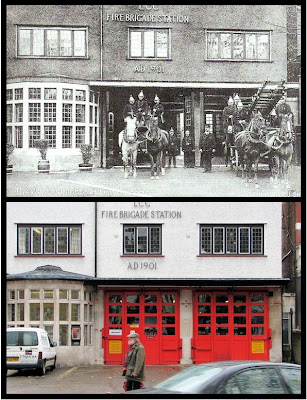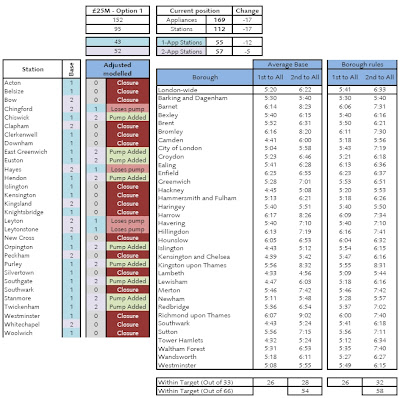Police station closure moves closer
As was widely expected – and reported in these pages back in November – West Hampstead police station is indeed set for closure.
This week, the draft consultation document was released that outlines which of London’s police stations will be shut. The document originates from the Mayor’s Office for Policing and Crime. This body runs the “estate” of the Met, i.e., the bricks and mortar.
The Estate Strategy (2012-2016) is “To deliver a more efficient and higher quality estate which meets the operational needs of the MPS and is significantly lower in cost to run.” The actual numbers are a 32 percent drop from £205 million in March this year to £140 million by April 2016. You’ll recall that the total cut to the Met’s budget is £500 million, so this £65 million is a relatively small part of that.
In “financial and space terms” (ie, “this means”) the Met will need to:
- “Enhance the opportunities for members of the public to meet with the police providing suitable access facilities in buildings that are already within the estate or local civic facilities, whilst also raising the profile of public facing properties through consistent standards of signage and corporate ‘look and feel’. [Yeeush. This is the “coffee shop police counters” bit]
- Reduce the running costs of the MOPAC estate to £140m each year by 2015/16 – a 30% reduction on 2012 costs. [This is the “sell off the buildings” bit]
- Reduce the amount of space occupied by 300,000 sq m by 2015/16. [see above]
- Provide up to 950 modern cells, reducing the cost of the custody estate, and providing suitable facilities to support the reduction in the time it takes for a detainee being taken into custody to be processed. [This is the “centralise detention” bit]
- To reduce the amount of residential accommodation owned by MOPAC to no more than 200 units whilst working with Residential Providers to provide affordable accommodation to officers and staff close to where they work.“ [This is the “force police officers to spend more time finding affordable accommodation” bit]
I’ve already discussed some of the broad principles here, but the core of the strategy as it relates to police stations is:
The Commissioner and the Mayor have committed to providing one 24 hour police station in each Borough and to not shutting any police station until there is a suitable alternative provision where the public can meet the police.
Camden’s 24hr station will be Holborn, Brent’s will be Wembley. Camden will also keep Kentish Town station open, although it will shift from being a 24hr station to a daytime station. West Hampstead, Albany Street and Hampstead stations will all close. Quite where the “suitable alternative provision” will be is not clear, but we’ll get to that in a moment.
It is debatable whether the closure of the front counter will have a major impact on most people. It’s not as if police officers are sitting at their desks waiting for someone to call 999 so they can jump in a car and hurtle to the scene of the crime. The impact of the larger cuts is likely to come more in the allocation of police resources across the regular officers, safer neighbourhood teams, and PCSOs rather than to the buildings.
 |
| We’re not in Dock Green any more |
Skinny latte and a search warrant please
Back to those contact points. For those times when someone does want to walk into a police station, where will they go? Much of the press has gone big on the “coffeeshop coppers” angle, but are the police really going to use Starbucks and Costa as temporary front counters? Here’s what the consultation document says:
Many public sector organisations are now exploring opportunities to share the publicly owned/occupied estate. This not only reduces costs but creates a more engaging and vibrant use of facilities – it creates a more friendly face.
Last time I looked, Starbucks in particular was not a “public sector organisation”. The document continues:
The MPS has recognised the need to enable the public to contact the police through a variety of different channels… The MPS describe this as ‘The Public Access Promise’. Since 2008, there has been a 20% reduction in crime reporting at front counters and a 32% increase in internet and email reporting. The Commissioner, for example, has committed that all victims of crime will be visited by a police officer if they wish rather than having to visit a police station – this benefits victims but also has a consequential effect on the need for police estate.
There’s no doubt that a Dixon of Dock Green style bobby waiting behind a front desk is both antiquated and probably largely (though not necessarily entirely) redundant. If Caroline Pigeon is right and one in four rapes are reported at front desks, then it would be interesting to know why that is so high. Surely, whatever the reason someone goes to a police station (voluntarily) they should have the right to a private room to explain their situation. That’s hard to find in a Costa, or outside a Sainsbury’s.
Not that the report appears to rule out completely working with the private sector (my emphasis):
As part of this estate strategy, MOPAC will further develop our relationships with other public sector bodies as well as private and third sector organisations specifically to find routes for the public to access the police in areas where they could access many other services.
Where might these places realistically be for us? The library is an obvious option. Perhaps the churches – St James’s is certainly looking to expand its role in the community. The foyer of the O2 centre is a regular spot for the Safer Neighbourhood roadshows, but could that replace a front counter?
The Public Access Strategy, which is being developed by the MPS, has highlighted that a number of front counters are underused. Once the strategy has been approved, following consultation initiatives, and the list finalised, those front counters will be replaced through the provision of ‘Contact Points’. The Contact Points will be in existing MPS and shared public buildings.
The pertinent question is then whether “shared public buildings” mean buildings owned by the public sector (libraries, sports centres) or buildings open to the public (shopping malls, cinemas etc.).
What I can’t understand is why Camden is apparently ruling out using the Safer Neighbourhood Base on West End Lane as a contact point? It’s an existing MPS building, it only needs to be manned whenever another contact point would be manned and the cost of making it accessible to the public would surely be fairly small – officers would have more resources on hand to deal with basic queries, there’s more privacy for members of the public, and even if a flat white was beyond officers’ ability I’m sure they could manage a milky Nescafé.
Will no-one think of the horses?
West Hampstead police station also houses some of the Met’s horses. It sounds as if their fate has yet to be decided:
The primary focus for the estate strategy is for the welfare of the animals and their proximity to where they are likely to be deployed. A review of this portfolio will be undertaken to assess the suitability of each property and location with the aim, if possible, to rationalise the number of buildings. Key Target: Opportunities will be considered for rationalising space into modern efficient facilities – delivering running cost savings of £0.5m each year.
That’s from a total budget of £2.4m. Police horses are used at large events of course, so proximity to Wembley might help keep the horses here – perhaps we’ll get more. Having lost the Kings Troop last year, it would be a shame to lose the police horses too, for no other reason than the character they add. And the opportunity for photos like this one taken by Adam Wilson last May.
 |
| “Shocking images in West Hampstead as horse eats policewoman’s head as she withdraws cash” |




